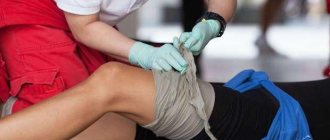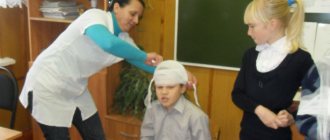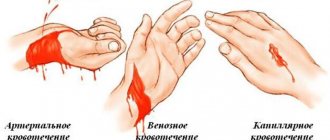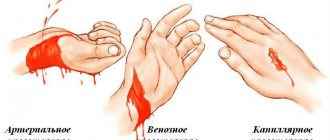When bleeding, the rate of blood loss can be a concern, so in many cases you need to act quickly. First aid measures depend on the type of bleeding, its location, the nature of the injury and some other factors. In this article we will talk about ways to combat blood loss in different situations.
Guidelines and a poster for stopping bleeding on the stand are available after the article.
Types of bleeding
Most often, bleeding is grouped according to anatomical principles, taking into account the damaged blood vessel.
According to this classification, there are 3 main types of bleeding :
- Arterial. The blood stream is pulsating and scarlet in color. It is characterized by a high rate of blood loss and is the most dangerous.
- Venous. The blood is dark and may flow more slowly.
- Capillary. The blood is bright red, appears slowly and in a small volume. Sometimes it appears in the form of small drops on the surface of the skin.
Separate topic: Types of external bleeding
There is also parenchymal bleeding, which cannot be seen. It occurs when the integrity of the liver, pancreas, and kidneys is damaged. Parenchymal bleeding is similar in nature to capillary bleeding, but poses a great danger to life. With deep penetrating wounds or damage to the integrity of internal organs, bleeding can be mixed.
Internal and external bleeding are also distinguished according to the direction of blood release. In the first case, blood accumulates in the cavities of the body, in the second, it comes out through wounds.
We recommend additional material: First aid for wounds
Long-term crush syndrome (Crush syndrome)
When a person gets caught in a rubble
- apply a tourniquet above the point of pressure and only then release
- released - tightly bandage the limb and remove the tourniquet
- plenty of warm drinks
- anti-shock measures and urgent hospitalization
This material is part of the School of First Aid course “Space of Safety”. We recommend signing up for classes at the school by calling +7 495 760—9092 or on the website https://www.allsafety.ru
Source: https://www.allsafety.ru/
Rules for applying a tourniquet
A tourniquet is applied only to stop arterial bleeding, and also if an arm or leg was amputated as a result of injury. In other cases, the use of a tourniquet is not advisable due to the high degree of injury to the skin and soft tissues. To temporarily stop bleeding, you can use an Esmarch tourniquet or a handy rubber material.
Rules for applying a tourniquet for bleeding
Basic rules and sequence of applying a tourniquet:
- If possible, raise your arm or leg for a few seconds and fix it in a comfortable position - this will lead to the outflow of venous blood.
- The tourniquet is applied over clothing or a piece of fabric is placed under it. This is necessary to protect the skin.
- The first two turns need to be made as tight as possible, they are the ones who stop the blood, while the crosshair is applied on the back side of the artery.
- The maximum duration of applying a tourniquet in the warm season should not exceed 90 minutes, in the cold season - 60 minutes. If during this time the victim cannot be taken to the hospital, the tourniquet should be loosened for 10-15 minutes and the artery should be pressed with a finger. Then the tourniquet is applied again, 1-2 cm above or below the previous location. The duration of applying a tourniquet to children should not exceed an hour.
- The time for applying the tourniquet must be written down and attached in a visible place. In reality, due to problems with drawing up (searching for paper and pens in field or combat conditions, while there are more pressing tasks of saving the life of the victim) and preserving (the paper gets soaked in blood and spreads or is simply lost) notes, in modern In practice, it is customary to write the time of application of the tourniquet with a marker directly on a visible place on the body, for example, it could be the forehead; it is recommended to indicate the name of the rescuer or the person who applied the tourniquet.
Esmarch rubber hemostatic tourniquet
Indications:
- traumatic amputation of a limb;
- inability to stop bleeding with other known means.
Advantages:
- quite fast and the most effective way to stop bleeding from the arteries of the limb.
Flaws:
- the use of a tourniquet leads to complete bleeding of the distal limbs due to compression of not only damaged great vessels, but also collaterals, which for more than 2 hours can lead to gangrene;
- nerve trunks are compressed, which causes post-traumatic plexitis with subsequent pain and orthopedic syndrome;
- cessation of blood circulation in the limb reduces the resistance of tissues to infection and reduces their regenerative abilities;
- the use of a tourniquet can cause severe vasospasm and lead to thrombosis of the operated artery;
- restoration of blood circulation after use of a tourniquet contributes to the development of tourniquet shock and acute renal failure;
- the use of a tourniquet is impossible on the torso or is limited in anatomically difficult areas.
Errors:
- its use without indications, that is, for venous and capillary bleeding;
- application on a naked body;
- far from the wound;
- weak or excessive tightening;
- poor fastening of the ends of the tourniquet;
- lack of accompanying note;
- use more than 2 hours;
- covering the tourniquet with a bandage or clothing.
If there is severe bleeding, a tourniquet is applied to the upper third of the shoulder or middle third of the thigh. In these areas, the anatomical location of the humerus and femur makes it possible to stop the bleeding with maximum efficiency. Applying a tourniquet in other places will not give the desired result. If a limb is torn off, applying a tourniquet is mandatory even in the absence of bleeding.
If the tourniquet is applied correctly, characteristic signs will appear after a while. The limb below the application site will turn pale and cold, the bleeding will stop, and the peripheral pulse will not be palpable. The intersection of the tourniquet should be on the outside of the arm or leg, since the artery is located on the axillary side.
Finger pressure
This technique should be used as a starting one when assisting a wounded person. The basic principles of digital compression depend on the anatomical region in which the artery injury occurred. The general rule is that the vessel should be pressed above the site of injury. But if bleeding occurs in the neck or head area, then the vessels are compressed downward from the wound. This is explained by the fact that the arteries in this area go upward from the heart.
Attention! When using any methods to stop bleeding, you need to lift the affected limb upward to reduce blood flow to it.
Damaged arterial vessels must be pressed against the bony protrusions, as they can slip out, and then bleeding will resume.
Places where arteries are pressed during bleeding
To better remember the method, you can use the 3D mnemonic rule:
- “Press.”
- "Ten".
- "Ten".
It means that you need to press the artery by pressing with ten fingers of both hands for 10 minutes, after which it is recommended to check whether the bleeding has stopped. If it is stopped, and this happens if it is not the main arterial vessel that is damaged, then you can limit yourself to applying a pressure aseptic dressing to the wound.
Since the blood pressure in the arteries is very high, it will take a lot of effort to apply pressure to the vessel and stop the bleeding. Finger pressure is a method of temporarily stopping bleeding, so while one person is pressing the artery, the second should already be looking for a tourniquet and dressing material. There should be no time wasted taking off clothes or freeing limbs. At the same time, one of the eyewitnesses must immediately call an ambulance to provide first aid and transport the victim to a hospital.
The biggest disadvantages of the finger pressing technique are:
- significant pain for the injured person;
- physical fatigue of the person providing emergency assistance.
Speed of execution is considered the most important advantage of temporarily stopping external arterial bleeding using finger pressure.
First aid
For arterial bleeding
If an artery is damaged, the bleeding is rapid, so you cannot hesitate. After quickly assessing the victim’s condition, measures must be taken to temporarily stop the bleeding. First, the artery is pinched with a finger; for this, certain points are used:
- If there is bleeding in the face, press the corner of the lower jaw with your thumb.
- In case of bleeding from the head, press on the area of the temporal bone in front of the ear.
- In case of arterial bleeding in the area of the shoulder joint, press the subclavian artery to the rib.
- If the hand is damaged, press the brachial artery to the bone from the side of the shoulder.
- If the integrity of the femoral artery is compromised, press with your fist on the pubic bone in the groin area.
First aid for arterial bleeding
After finger pressure, a tourniquet is applied in compliance with the rules described above. If you don’t have a tourniquet or similar material at hand, you can apply a twist. To do this, use a piece of twine or fabric. A loop is made from the material and placed on the desired area of the limb. A metal or wooden rod is inserted into the loop, with the help of which the bandage is twisted. Further actions are the same as when stopping bleeding using a tourniquet.
For venous bleeding
In most cases, it is easier to stop bleeding from a vein than from an artery, so neither a tourniquet nor a twist is practically used.
The algorithm for providing first aid is as follows:
- The wound is covered with several layers of bandage, napkins or any clean piece of fabric.
- Sterile cotton wool is placed on top.
- Fix everything tightly with a bandage, scarf or piece of fabric of the required width.
To consolidate the effect, the damaged limb is raised so that it is higher than the body and fixed. If it is not possible to apply a bandage, the wound is packed with a tightly rolled bandage. Sometimes this is enough to stop the bleeding.
If there is severe bleeding from a vein, a pressure bandage may be useless. In this case, you need to apply a tourniquet and apply an ice pack to the wound. After this, the victim must be taken to the nearest hospital.
For capillary bleeding
In most cases, capillary bleeding does not pose a threat to the life of the victim and, if first aid measures were correct, does not cause complications.
To stop bleeding during external bleeding, you must adhere to the following sequence:
- Treat the skin area with any antiseptic.
- Apply a napkin and secure it with a bandage;
- If a limb is injured, raise it relative to the body.
With various injuries or diseases, nosebleeds may begin. It occurs in case of damage to the blood vessels located in the mucous membrane; it can stop on its own, but in severe cases, first-aid treatment will be required.
First of all, you need to press the wing of the nose to the nasal septum. For minor damage to blood vessels, the bleeding should stop after 10 minutes. If this does not happen, a nasal tamponade is performed. In case of nosebleeds, you need to monitor the well-being of the victim and warn him that he needs to breathe through his mouth.
First aid for types of bleeding
Possible dangers and complications
If the above rules are not followed, pathological contraction of body parts can lead to extremely undesirable consequences that can cause serious damage to human health and life. This may include:
- Necrosis of the limb, which develops due to the lack of adequate blood supply to the underlying tissues. This is preceded by a feeling of numbness, so it is worth paying close attention and asking the person about it (if he is conscious). If it is not possible to maintain communication, the main marker of the normal functioning of the blood flow will be the pulse in the vein, which can be easily heard with your fingers;
- The tourniquet is always applied below the level of the wound; failure to comply with this condition can lead to the death of the victim due to blood loss, which, with proper organization of measures, could be prevented;
- In case of injury to the veins of the neck and head, delay in calling an ambulance or improper provision of assistance can provoke a cerebral stroke or irreversible changes in brain structures: dementia, disorders of the speech center, memory and even visual perception;
- Massive blood loss can provoke renal failure, which in most cases leads to death;
- A weak heart can respond to massive blood loss with myocardial infarction, which should also be taken into account when providing support; a nitroglycerin tablet under the tongue will prevent this phenomenon and help you wait for an ambulance.
How to properly apply a hemostatic tourniquet
In order not to harm the victim, it is necessary to approach the process of applying a tourniquet with all responsibility and perform it in accordance with the rules:
- in order to reduce blood flow, the injured limb should be slightly elevated, for example, placed on a rolled up towel;
- to avoid damage to the skin, it is necessary to place a soft cloth under the tourniquet; this procedure will also help reduce pain;
- if the injury is on the leg, then the product must be applied to the thigh area, if the arm is injured, the tourniquet should be attached to the shoulder;
- the tourniquet should be positioned with the concave side inward;
- when pulling the product under the limb, you must ensure that the right side of the tape is slightly longer than the left;
- It is necessary to apply the tourniquet with effort. Each subsequent turn should be slightly weaker than the previous one and should overlap it, which will avoid damage to soft tissues;
- the harness is secured with hooks and a chain located at the ends of the product.










